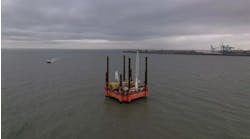ADIPEC 2024: Addressing oxygen challenges with catalytic deoxygenation ensures CO2 purity offshore
By Ekaterina Novakova, Johnson Matthey
As industries intensify efforts to curb greenhouse-gas emissions, particularly through carbon capture, utilization and storage (CCUS), controling oxygen impurities in CO2 streams becomes vital. Offshore CO2 transport infrastructure faces unique and potentially very costly challenges where oxygen impurities can trigger severe corrosion when interacting with nitrogen and sulphur oxides, forming acids that threaten pipeline integrity. To mitigate these risks and achieve stringent purity standards essential for reliable offshore CO2 transport, catalytic deoxygenation technology emerges as a robust, efficient solution for oxygen removal under the demanding conditions of offshore applications.
CO2 transport systems, whether pipeline or liquefied, face unique challenges offshore where environmental and compositional factors can vary, and accessibility is limited. CO2 streams from various sources, including pre-combustion, post-combustion and biogenic processes, introduce diverse impurities, each impacting downstream transport and storage infrastructure.
To meet the standards required for safe transport, stringent oxygen content limits are typically enforced: under 10 ppmv for pipelines and less than 1 ppmv for liquefied CO2 transport. Controlling oxygen to these levels mitigates corrosion risk, helping to ensure long-term transport reliability, which is a factor of heightened importance in remote and challenging offshore environments where maintenance and repair are complex undertakings.
Three primary technologies are available for oxygen removal from CO2 streams:
- Catalytic oxidation
- Chemisorption
- Cryogenic distillation
Among these, catalytic oxidation has emerged as a highly effective and practical method due to its operational efficiency and cost-effectiveness.
Catalytic deoxygenation utilizes platinum group metal (PGM) catalysts, including platinum and palladium, to facilitate the reaction of oxygen with hydrogen in CO2 streams. This approach is particularly advantageous in offshore settings as it enables continuous operation without the high capital and energy requirements of chemisorption and cryogenic methods.
Catalytic oxidation, a process established in urea production, has a long track record of reliable performance under variable offshore conditions. Using hydrogen as a co-reactant, catalytic oxidation converts oxygen into water. This reaction is facile, well-established technology with a robust operational history. For example, Johnson Matthey’s PURAVOC BLUE catalyst has been developed specifically for deoxygenation in challenging conditions, combining reliability with a design that requires minimal intervention.
Key considerations in catalytic deoxygenation
Implementing catalytic deoxygenation involves several critical factors that influence catalyst performance and longevity, and ultimately, the effectiveness of oxygen removal. These considerations include water management, managing catalyst poisons and accommodating operational patterns.
Key considerations in catalytic deoxygenation include
- Water management:
Water must be removed to prevent integrity issues with the CO2 transportation systems; the required specification is well understood. Catalytic deoxygenation using hydrogen produces water as a product, which needs to be considered in the overall water balance. Thus, it is advantageous from an operational and economic point of view that dehydration can be carried out in a single step, downstream from the catalytic deoxygenation.
CO2 sources, such as amine capture units, often contain saturated water levels that can block active sites on PGM catalysts, thereby reducing the catalyst’s efficiency. JM’s PURAVOC BLUE catalysts have been shown to operate efficiently and effectively in high-humidity streams at reaction temperatures just above the dew point at the operating pressure.
2. Managing catalyst poisons:
CO2 streams may contain trace impurities, such as sulphur compounds and heavy metals, that degrade catalysts over time. Known as "catalyst poisons," these impurities dictate optimal placement of the deoxygenation unit within the process flow. Positioning the catalytic oxidation stage downstream of bulk gas conditioning can remove many contaminants before contact with the catalyst, enhancing its lifespan and effectiveness. Circular PGM management services further allow for the recycling of spent materials, supporting sustainable and cost-effective operations.
3. Adapting to operational intermittency:
CO2 conditioning often operates under varying flow rates or intermittent patterns due to fluctuations in CO2 production. While catalysts generally perform best under steady-state conditions, testing has shown that PURAVOC BLUE catalysts maintain resilience and recover full function after interruptions, even when flow rates fluctuate or the system is periodically shut down.
Catalysts have demonstrated the ability to recover optimal performance after periods of reduced or halted flow, which is advantageous for offshore operations that experience inconsistent CO2 production rates.
Conclusion
Applying catalytic deoxygenation to CO2 conditioning offers significant advantages, particularly for offshore transport safety and reliability. By reducing the risk of corrosion from oxygen impurities, deoxygenation helps maintain the integrity of CO2 transport infrastructure, a key consideration for offshore installations where operational interruptions are costly and repairs are logistically challenging.
The catalytic oxidation process is also economically advantageous compared to alternatives due to its relatively low capital and energy requirements. While chemisorption and cryogenic distillation are technically viable, their higher costs and energy demands make them less practical for offshore applications where efficiency is crucial. Circular management of PGMs within deoxygenation systems further supports sustainable operations by enabling the recycling of catalyst materials, thereby reducing environmental impact and long-term operational costs.
Catalytic deoxygenation addresses these crucial challenges by enabling reliable oxygen removal. Proven performance under a range of conditions makes catalytic deoxygenation a practical and effective method for meeting CO2 purity requirements, providing a foundation for safe, long-term offshore CO2 storage and transport.




